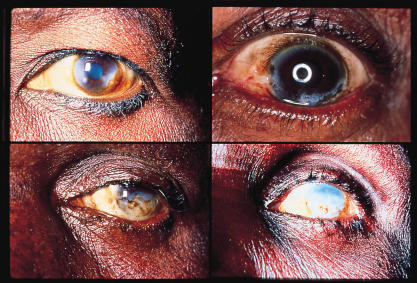Onchocerciasis, commonly referred to as river blindness, is a neglected tropical disease (NTD) caused by the filarial parasitic worm Onchocerca volvulus. It is transmitted to humans through the bite of infected blackflies (Simulium species), which breed near fast-flowing rivers and streams—hence the term “river blindness.” The disease predominantly affects sub-Saharan Africa, but cases also exist in Latin America and Yemen.
The condition can cause severe itching, skin lesions, visual impairment, and permanent blindness. Long-term, widespread infection can lead to devastating socio-economic consequences in endemic areas.

Causative Agent: Onchocerca volvulus
Onchocerca volvulus is a filarial nematode. Humans are the only known definitive host, and the disease is perpetuated through repeated bites from infected blackflies.
Geographic Distribution and Endemic Regions
Onchocerciasis is endemic in:
- 31 countries in sub-Saharan Africa (Nigeria, Democratic Republic of Congo, Ethiopia)
- Isolated foci in Latin America (Brazil, Venezuela)
- Yemen in the Arabian Peninsula
Over 200 million people live in at-risk areas, and more than 20 million are infected, with over 1 million affected by vision loss.
Symptoms and Clinical Manifestations of Onchocerciasis
The manifestations of onchocerciasis are primarily due to the immune response to dying microfilariae. Symptoms may range from mild itching to debilitating blindness.
Dermatological Symptoms:
- Intense pruritus (itching)
- Rash with hyperpigmented macules
- Lichenification and skin thickening
- Leopard skin (depigmented patches on lower limbs)
- Sowda (localized, intensely pruritic, swollen, darkened skin – seen in Yemen and parts of East Africa)
Ocular Symptoms (River Blindness):
- Punctate keratitis: Early clouding of the cornea
- Sclerosing keratitis: Progressive opacification leading to vision loss
- Chorioretinitis and optic neuritis
- Blindness: Often irreversible if not treated early
Nodules:
- Onchocercomas: Subcutaneous fibrous nodules containing adult worms, commonly found on bony prominences like the pelvis, ribs, and scalp.
Diagnosis of Onchocerciasis
Clinical Assessment:
Diagnosis is primarily clinical in endemic regions and includes assessment of:
- Chronic pruritus and skin changes
- Presence of nodules
- Visual symptoms or signs of keratitis
Diagnostic Methods:
- Skin snip biopsy: Gold standard. A small piece of skin is taken, incubated, and examined microscopically for microfilariae.
- Nodulectomy and microscopic examination: To identify adult worms
- Ophthalmoscopy: Detects microfilariae in the anterior chamber or retina
- Serologic tests: ELISA and OV-16 antibody detection (useful in surveillance)
- PCR assays: High sensitivity, detects parasite DNA in skin or blood
Treatment and Management of Onchocerciasis
Effective treatment strategies reduce parasite load, alleviate symptoms, and prevent complications. Control efforts also focus on interrupting transmission.
Pharmacological Treatment:
1. Ivermectin
- Administered every 6 to 12 months.
- Kills microfilariae, alleviating skin and eye symptoms.
- Does not kill adult worms.
- Single dose: 150 µg/kg orally.
2. Doxycycline
- Targets the Wolbachia endosymbionts in adult worms.
- Reduces adult worm fertility and lifespan.
- Regimen: 100 mg daily for 4–6 weeks.
- Useful in breaking transmission cycles.
3. Surgical Removal
- Nodulectomy may be indicated for symptomatic or accessible nodules.
Prevention of Onchocerciasis
Preventing onchocerciasis requires a comprehensive approach involving mass drug administration (MDA), vector control, and community education.
Community-Directed Treatment with Ivermectin (CDTI)
- Backbone of onchocerciasis control programs.
- Delivered through trained local volunteers.
- Administered annually or biannually.
Vector Control:
- Larviciding rivers to eliminate blackfly breeding grounds.
- Use of environmental management techniques.
Personal Protective Measures:
- Wearing long-sleeved clothing near rivers.
- Using insect repellents.
- Avoiding areas of high blackfly activity, especially during peak biting hours (morning and evening).
Elimination Efforts and Global Programs
African Programme for Onchocerciasis Control (APOC)
- Coordinated ivermectin distribution across endemic countries.
- Transitioned into Expanded Special Project for Elimination of NTDs (ESPEN) in 2016.
Onchocerciasis Elimination Program of the Americas (OEPA)
- Achieved elimination in Colombia, Ecuador, Mexico, and Guatemala.
- Remaining transmission occurs in Venezuela and Brazil (Amazonian regions).
WHO Goals:
- Eliminate onchocerciasis as a public health problem globally by 2030.
Complications of Untreated Onchocerciasis
- Irreversible blindness
- Disfiguring skin disease
- Social stigma and isolation
- Economic loss due to decreased productivity and dependency
- Increased risk of epilepsy and nodding syndrome (association under study)
Frequently Asked Questions:
Q1: What is the main cause of onchocerciasis?
The disease is caused by infection with the parasitic worm Onchocerca volvulus, transmitted through bites of infected blackflies.
Q2: How does onchocerciasis lead to blindness?
Microfilariae migrate to the eyes, where they trigger an immune response that leads to corneal opacity and retinal damage, eventually causing blindness.
Q3: Can onchocerciasis be cured?
While there is no immediate cure, long-term treatment with ivermectin and doxycycline can eliminate microfilariae and gradually sterilize adult worms.
Q4: Is onchocerciasis contagious?
No. It is not spread from person to person, but through the bite of infected blackflies.
Q5: How can we prevent onchocerciasis in endemic areas?
Regular mass ivermectin treatment, vector control, and community education are key to breaking the transmission cycle.
Onchocerciasis is a major public health concern in several regions of the world, especially in sub-Saharan Africa. Characterized by chronic skin disease and blindness, the condition demands sustained efforts in diagnosis, treatment, and prevention. Thanks to global initiatives and mass drug administration campaigns, remarkable progress has been made. However, complete elimination hinges on continuous surveillance, integration of vector control, and community engagement. Collective action remains essential to consign this devastating disease to history.